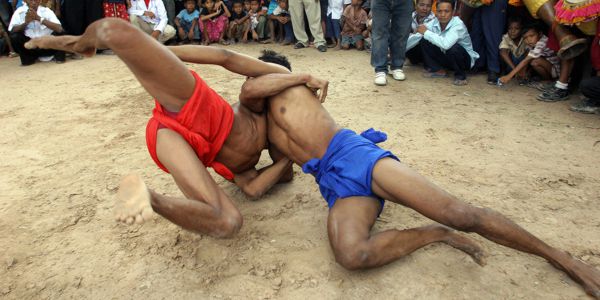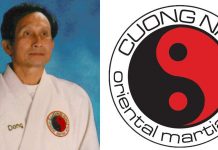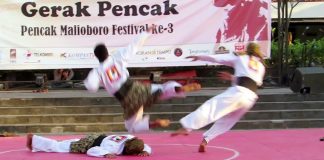The Khmer traditional wrestling championships take place each August, in the Olympic stadium, along side the modern Olympic Wrestling Championships. Although held on the same day, the two sports differ dramatically in both execution and outcome.
Fighting in the Dirt is a Matter of Preserving Khmer Heritage
 Two drums beat. Wrestlers, dressed in colorful gonsain (loin cloths) dance. As they whirl around the mats, they take the forms of various animals, the monkey, the crocodile, or the dragon. The dancing, which could last several minutes, serves the dual purpose of warming up their muscles, and paying respect to their trainers. When the signal is given, they tear at each other in a frenzy, trying to throw one another. The drum beats faster. The men look like two crocodiles locked up in a battle to the death.
Two drums beat. Wrestlers, dressed in colorful gonsain (loin cloths) dance. As they whirl around the mats, they take the forms of various animals, the monkey, the crocodile, or the dragon. The dancing, which could last several minutes, serves the dual purpose of warming up their muscles, and paying respect to their trainers. When the signal is given, they tear at each other in a frenzy, trying to throw one another. The drum beats faster. The men look like two crocodiles locked up in a battle to the death.
 Seeing that neither will gain an advantage, they break off, and resume their dance. The bout continues, in this fashion, with the men alternately wrestling and dancing. Finally, one manages to throw the other. There is a scramble on the ground, until one opponent allows either his shoulder blades or chest to touch the floor. The referee steps in and declares a winner.
Seeing that neither will gain an advantage, they break off, and resume their dance. The bout continues, in this fashion, with the men alternately wrestling and dancing. Finally, one manages to throw the other. There is a scramble on the ground, until one opponent allows either his shoulder blades or chest to touch the floor. The referee steps in and declares a winner.
 After receiving his trophy, the winner dances again.
After receiving his trophy, the winner dances again.
The Khmer traditional wrestling championships take place each August, in the Olympic stadium, along side the modern Olympic Wrestling Championships. Although held on the same day, the two sports differ dramatically in both execution and outcome. Olympic wrestling is a sport, played by modern athletes wearing singlets made of spandex. The national team, based in Phnom Penh, is composed of 16 members, ten men and six women. Naturally, they lead the nation in the number of medals won. Both of the team’s coaches were trained abroad, one in Russia and one in North Korea. In addition to having proper equipment and twice-daily training sessions, the members of the national team receive a monthly cash stipend of thirty dollars, which, although a paltry sum by western standards is slightly higher than the average income of $26 in Cambodia. With so many advantages it is nearly impossible for provincial teams to compete.
The world of traditional wrestling, on the other hand, is a level playing field, dominated by the teams from Prusat and Kandal provinces.
 According to Vath Chamreun, a wrestling official and leading trainer in Phnom Penh, “The best wrestlers are from Prusat Province.” He was quick to point out that entrants in the Olympic wrestling competition were barred from participation in the traditional wrestling competition.
According to Vath Chamreun, a wrestling official and leading trainer in Phnom Penh, “The best wrestlers are from Prusat Province.” He was quick to point out that entrants in the Olympic wrestling competition were barred from participation in the traditional wrestling competition.
While the sport of Khmer wrestling is dying out, many see preservation of the sport as a matter of national pride and culture.
“Before the Khmer Rouge, nearly every village wrestled.” Explained Vath Chamreun. “They wrestled at festivals and on holidays, such as Khmer New Year or Pchum Benh. But the art was banned during the Khmer Rouge time and many of the top wrestlers and coaches were killed.” In the 1980’s, under the Vietnamese, the wrestling was still banned. “In 1985, Prusat was the first province to have wrestling again. It wasn’t official, they just started doing it.”
Vath Chamreun laughed, and made it sound as if some village men, drunk on rice wine, started having a go at each other. And this was the rebirth of Khmer traditional wrestling. After the end of the Vietnamese domination of Cambodia, some villages resumed wrestling, although most did not. The first official championships were not held until 2001.
“In some provinces the wrestling has started up again, but it has been incorporated into Bokator and other traditional Khmer martial arts. So, it is no longer pure wrestling.”
“There were many martial arts in Cambodia, dating back to the Angkorian or pre-ankorian period.” Explained Vath Chamreun, who is working on a book of Khmer fighting sports. “Khmer wrestling was just one part of Khmer martial art. They used wrestling to chose the strongest men to be the military leaders. They also incorporated wrestling into military training. First, the soldiers trained wrestling. Later, they trained with swords, sticks, and other weapons.”
As historical proof, Vath Chamreun referenced the bass relieves, carved on the walls of the ancient temples, such as Angkor Wat, depicting soldiers in wrestling poses.
“Each year, the king’s representatives called all the people from the provinces and organized a wrestling tournament. Anyone could fight. There were no weight divisions. One person would enter the circle and the official would say, who will fight him? And, volunteers came. They used incense sticks, cut in half, to time the rounds.” They fought three rounds. “If you lost a round they would ask you, are you strong or do you want to quit?”
If you quit, you lost. If you continued, the first person to get three wins won the game. A pin wasn’t needed. When you were thrown on the ground, that was a lose.
“There were no technical rules, just throw the man down.” Laughed Vath Chamreun. At the time of Angkor, you could also use some martial arts techniques such as kicks.” Apparently, if a man was being thrown, he was allowed to kick, but only when he was in the air.
When Vath Chamreun was a child, some old men told him about the days when you could kick. “It was very dangerous, since nearly all the kicks were in the head. People got killed all the time.”
As a result, you are not allowed to strike, today.
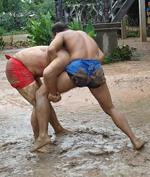 Comparing Khmer wrestling with other martial arts, Vath Chamreun said. “When a wrestler and a martial artist fight, the wrestler must get very low, so he can’t be hit.” Demonstrating, Vath Chamreun ducked under my punch and grabbed the nerve beneath my lat muscle. Then he twisted his body and grabbed my leg. He lifted and threw me on my back. “Wrestler against boxer, the wrestler has to be willing to sacrifice. He will get hit several times. But then he can throw the boxer.”
Comparing Khmer wrestling with other martial arts, Vath Chamreun said. “When a wrestler and a martial artist fight, the wrestler must get very low, so he can’t be hit.” Demonstrating, Vath Chamreun ducked under my punch and grabbed the nerve beneath my lat muscle. Then he twisted his body and grabbed my leg. He lifted and threw me on my back. “Wrestler against boxer, the wrestler has to be willing to sacrifice. He will get hit several times. But then he can throw the boxer.”
He demonstrated another technique where he grabbed me around my middle and turned his knuckles into the small of my back. When he applied pressure, I could feel bone grinding on bone. Once again, he lifted me and threw me. He assured me that both moves could be done with gloves on.
 “In the old days, Khmer boxing, Bradal Serey, was done without gloves and no rules. These types of grappling moves were common.”
“In the old days, Khmer boxing, Bradal Serey, was done without gloves and no rules. These types of grappling moves were common.”
In another scenario, throwing from the boxing clinch, Vath Chamreun landed on top of me, head butting me in the jaw. Done at full speed, a single head butt to the jaw could end a fight quickly.
The continued existence of Khmer wrestling is greatly dependent upon the provincial people. Unfortunately, resurrecting any cultural asset in the provinces is problematic. Most provincial families are subsistence farmers, concerned more with earning a living and having enough to eat than they are about playing sports. The poverty also robs them of strength, making it impossible to train. Even for the national sport, Khmer boxing (Bradal Serey), it is difficult to keep the tradition alive. Most provincial boxing coaches said that their students only trained in the dry season, because the roads were impassable in the rainy season and because the boys were needed back at their family farms. At least with boxing there is the chance of someday turning pro and earning an income. But most provincial families see wrestling and other sports as a dead end. They would invest a lot of time and energy for nothing.
As a result, traditional wrestling teams don’t have regular practices. Most only prepare for a few days before the competitions. For many villages, the only competition they participate in is the National Championships.
The Khmer Traditional Wrestling Championships are a sterile affair. To see the real event, practiced as it once was, you need to visit a village in Kandal Province, on Pchum Benh holiday.
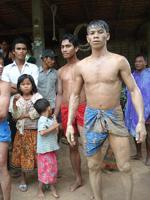 The village inhabitants wake up at 5:00 AM and walk to the Wat, where they toss food offerings on the ground, in honor of their ancestors. Next, they go to the shrine and receive a blessing from the monks. The first event of the day is the buffalo racing, which is done, in pairs, racing three hundred to five hundred meters beginning at the temple. The winner normally receives a small cash prize of about 10,000 Riels ($2.50) provided by the local government. When everyone has had a chance to race, the wrestlers change clothes. They light incense sticks at the temple, and then insert the sticks in the ground, in a circle, forming the wrestling ring.
The village inhabitants wake up at 5:00 AM and walk to the Wat, where they toss food offerings on the ground, in honor of their ancestors. Next, they go to the shrine and receive a blessing from the monks. The first event of the day is the buffalo racing, which is done, in pairs, racing three hundred to five hundred meters beginning at the temple. The winner normally receives a small cash prize of about 10,000 Riels ($2.50) provided by the local government. When everyone has had a chance to race, the wrestlers change clothes. They light incense sticks at the temple, and then insert the sticks in the ground, in a circle, forming the wrestling ring.
The wrestlers can earn small sums of money, put up by the village officials. Sometimes they can also get tips from visiting dignitaries or tourists.
A small ensemble of two drums and no string instruments plays, as the men wrestle. At the same time, there are traditional stick fights. The stick fights, like the wrestling and boxing, are accompanied by music and preceded by dance. In these battles, the men fight with long staffs, really striking at each other. Every time they make contact with their opponent’s head or body, they earn a point. The one with the most points wins. The stick fighting was different than other types of stick fighting I had seen elsewhere in Asia. The men often held the stick by the end and swung it like a baseball bat. Another common technique was thrusting, where the stick was held like a spear, and one opponent would stab at the other.
“This is a real fight.” Insisted Japleun, one of Phnom Penh’s leading wrestlers, and a native son of the Kandal Village. “The men are really fighting, because they want to win.”
Other than the obvious dangers associated with hitting each other in the head with a six foot wooden pole, it seemed that great care was taken to preserve the health and safety of the village competitors. For example, when I trained with Japleun at the Olympic Stadium, I saw him win by suplex, tossing an opponent over his head. But here in the village, such techniques were banned, as they might cause injury. In most bouts, when one opponent managed to get into a throwing position, the bout was stopped and a win was awarded.
On the day Japleun took me to his village, the rain poured, turning the dirt road into a sea of mud, and we swerved to avoid hitting a young boy ridding a water buffalo. Our car skidded to a halt in Vihear Sour village, Kandal province. My companions were Hok Chheang Kim the head coach of the national wrestling team and Chap Loeun, the 27 year old, 73 kg Cambodian wrestling champion. In spite of the heavy rain, the villagers came out in droves to welcome the hero home.
While Japleum signed autographs, Coach Kim told me about the days when he trained in Russia. “I went there to learn to be a wrestling coach. It was snowing in September, when I arrived and still snowing six months later when I left.”
 The villagers tied a diaper around my waist and under my legs. All the men in the village were wearing similar attire. Half wore red and half wore blue, like in kick boxing. The rules were simple. Place your opponent’s back on the ground and you get a point. Three points is a win. So, when the score reaches two to zero, the fight is over. Fights were quick and furious. One wrestler would shoot in but in the muddy, dirty ground, it was hard to do a controlled slide. The fighters would lock up, toss and roll. Chaploeun was exceptionally skilled from his years of experience training in Phnom Penh. He did some complicated maneuvers, such as lifting and flipping his opponents.
The villagers tied a diaper around my waist and under my legs. All the men in the village were wearing similar attire. Half wore red and half wore blue, like in kick boxing. The rules were simple. Place your opponent’s back on the ground and you get a point. Three points is a win. So, when the score reaches two to zero, the fight is over. Fights were quick and furious. One wrestler would shoot in but in the muddy, dirty ground, it was hard to do a controlled slide. The fighters would lock up, toss and roll. Chaploeun was exceptionally skilled from his years of experience training in Phnom Penh. He did some complicated maneuvers, such as lifting and flipping his opponents.
When it came my turn, I found it hard not to let my back touch the gound. In free style fighting (Mixed Martial Arts), it is perfectly acceptable and even advantageous to fight from your back. Several times, my opponent and I locked up. I was able to get him in a reverse full nelson, then spin around and take his back. Normally at that point I would throw my weight backwards pulling him down on top of me, lock my legs around his (grape hooks) and choke him out (rear naked choke). In Khmer wrestling, unfortunately for me, the second my back hit the ground I had lost.
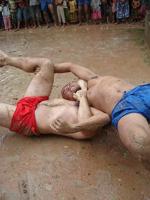 Wrestling on a clean matt in Phnom Penh was one thing, but wrestling barefoot, in the dirt, as it was traditionally done, was something else. The rain and sweat made it hard to grab your opponent. The mud was gritty and ground into your butt crack and abrased the skin, it also irritating inside my diaper. Wet sand ran into my mouth and I suddenly knew how an oyster felt. I made a pearl the size of an orange.
Wrestling on a clean matt in Phnom Penh was one thing, but wrestling barefoot, in the dirt, as it was traditionally done, was something else. The rain and sweat made it hard to grab your opponent. The mud was gritty and ground into your butt crack and abrased the skin, it also irritating inside my diaper. Wet sand ran into my mouth and I suddenly knew how an oyster felt. I made a pearl the size of an orange.
My fights had a bit of panache, but I lost all of my bouts. This was particularly pathetic since I outweighed most of my opponents by about forty kilos. Of course this was allowed since there are no weight divisions in Khmer Traditional Wrestling.
Seeing how badly I did, one very old woman said. “Please come back for Pchum Benh.” I think she was planning to match me with the smallest guy in the village and bet against me.
Japleun introduced me to the village wrestling coach, The Thain, who explained that they didn’t practice regularly, like the team at the Olympic Stadium. According to him, every man woman and child in the village could wrestle. Even the women compete in traditional wrestling.
“They don’t need to train.” Said The Thain. “When they bring the buffalo to the rice fields, they wrestle amongst themselves. Particularly, one month before Pchum Benh, they wrestle in the fields to prepare for the big day.” The Thain explained that wrestling was a kind of play for the village boys who were bored with their farm work. “Some only train three days or one night before Pchum Ben.”
 My wrestling ordeal behind me, all the wrestlers and I took a shower, Khmer village style. Normally, people in these kinds of villages don’t even have running water, so they stand outside their house and dump buckets over their head, wearing a sarong. In this village, however, one man had a compressor pump. He fired it up, attached a fire hose to it, and we all got hosed off, like in a prison movie.
My wrestling ordeal behind me, all the wrestlers and I took a shower, Khmer village style. Normally, people in these kinds of villages don’t even have running water, so they stand outside their house and dump buckets over their head, wearing a sarong. In this village, however, one man had a compressor pump. He fired it up, attached a fire hose to it, and we all got hosed off, like in a prison movie.
 After we had changed clothes, Chapleun took me to the temple, Wat Vehea Sua, where he showed me the statue of the village patron saint, General Meun Ek. He is the military commander who defended Cambodia from Thailand. Before boys from the village go to the army, the first pray before the statue. They take a small piece of dirt from behind the statue, and carry it with them for protection.
After we had changed clothes, Chapleun took me to the temple, Wat Vehea Sua, where he showed me the statue of the village patron saint, General Meun Ek. He is the military commander who defended Cambodia from Thailand. Before boys from the village go to the army, the first pray before the statue. They take a small piece of dirt from behind the statue, and carry it with them for protection.
“Every club prays before they wrestle. Said Japleun. “They have small Hindu statues and give thanks to the ancestors for creating martial arts. We pray, please stay in my heart and make me strong.”
 Inside the temple, there was yet another live band, playing music.
Inside the temple, there was yet another live band, playing music.
“We pray for the spirit of the Wat.” Japleun, pointing at a Buddha statue.
 “If they play music the spirit will welcome you.” Explained Kimsong, who is an expert on Khmer religion and culture. “After that, he will recognize you and protect you wherever you go. In our mind we can say, Buddha please protect us from enemies and give us success and prosperity.”
“If they play music the spirit will welcome you.” Explained Kimsong, who is an expert on Khmer religion and culture. “After that, he will recognize you and protect you wherever you go. In our mind we can say, Buddha please protect us from enemies and give us success and prosperity.”
Kimsong ended by telling me, “The music is a language for us to communicate with the spirits of the gods.”
Perhaps playing music at traditional wrestling, boxing, stick fighting and other events is a way of asking the gods to preserve the Khmer culture.

